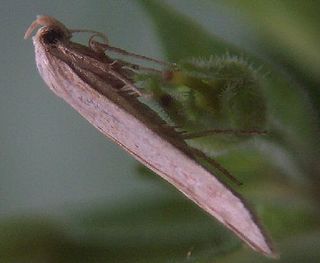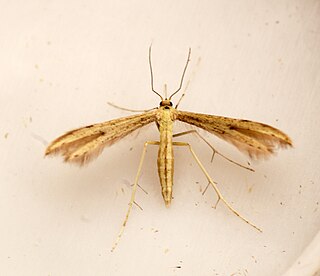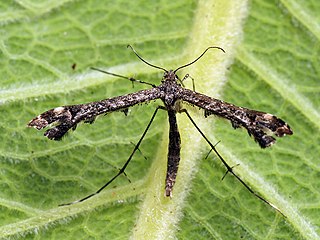
Pterophorus pentadactyla, commonly known as the white plume moth, is a moth in the family Pterophoridae. It is found in the West Palearctic including North Africa and Europe. The wingspan is 26–34 mm (1.0–1.3 in). It is uniformly white, with the hind wing pair divided in three feathery plumes and the front pair in another two. The moths fly from June to August. The larvae feed on bindweed.

Stenoptilia pterodactyla, the brown plume is a moth of the family Pterophoroidea. It is found in Europe, North America, Anatolia, Iran and China. It was first described by the Swedish taxonomist, Carl Linnaeus in 1761.

Elachista rufocinerea is a moth of the family Elachistidae found in Europe.

Platyptilia gonodactyla, also known as the triangle plume, is a moth of the family Pterophoridae found in temperate Asia and Europe. It was first described by the Austrian entomologists, Michael Denis & Ignaz Schiffermüller in 1775.

Amblyptilia acanthadactyla, also known as the beautiful plume, is a moth of the family Pterophoroidea found in across the Palearctic including Europe. The species was first described by the German entomologist, Jacob Hübner in 1813.

Stenoptilia bipunctidactyla, also known as the twin-spot plume is a moth of the Pterophoroidea family found in North Africa, Asia and Europe. It was first described by the Austrian physician and naturalist, Giovanni Antonio Scopoli in 1763. It is one of four similar looking moths.

Ditula angustiorana, the red-barred tortrix, is a moth of the family Tortricidae found in Africa, Asia, Europe and North Africa. Other common names are the fruit-tree tortrix and the vine tortrix. The moth was first described by Adrian Hardy Haworth in 1811.

Gillmeria pallidactyla is a moth of the family Pterophoridae first described by the English entomologist, Adrian Hardy Haworth in 1811. It has a Holarctic distribution and is widespread throughout North America and the Palearctic.

Hellinsia osteodactyla is a moth of the family Pterophoridae. It is found in most of Europe, as well as North Africa and from Asia Minor to Japan. Also known as the small golden-rod plume it was first described by Philipp Christoph Zeller in 1841.

Hellinsia lienigianus is a moth of the family Pterophoridae which inhabits coastal areas, dry pastures and waste ground and is found in Africa, Asia, Australia and Europe. Also known as the mugwort plume it was first described by Philipp Christoph Zeller in 1852.

Adaina microdactyla is a moth of the family Pterophoridae first described by Jacob Hübner in 1813. Also known as the hemp-agrimony plume, it is found in Africa, Asia and Europe.

Amblyptilia is a genus of moths in the family Pterophoridae. The genus was raised by the German entomologist, Jacob Hübner in 1825.

Agdistis bennetii is a moth of the family Pterophoridae found in Europe. It inhabits salt marshes.
Agdistis tamaricis is a moth of the family Pterophoridae found in Africa, Asia and Europe. It was first described by the German entomologist, Philipp Christoph Zeller in 1847.

Oxyptilus parvidactyla, also known as the small plume, is a moth of the family Pterophoridae found in Africa, America latina, Asia and Europe. It was first described by Adrian Hardy Haworth in 1811.

Crombrugghia distans, also known as the Breckland plume is a moth of the family Pterophoridae found in Africa, Asia and Europe. It was first described by Philipp Christoph Zeller in 1847.

Crombrugghia laetus, also known as the scarce light plume is a moth of the family Pterophoridae, found in southern Europe, North Africa, the Canary Islands, Asia Minor and Iraq. It was first described by the German entomologist, Philipp Christoph Zeller in 1847.

Marasmarcha lunaedactyla, also known as the crescent plume is a moth of the family Pterophoridae found in most of Europe. It was first described by Adrian Hardy Haworth in 1811.

Merrifieldia leucodactyla, also known as the thyme plume, is a moth of the family Pterophoridae, and is known from most of Europe, as well as North Africa and Asia Minor. It was first described by the Austrian lepidopterists, Michael Denis and Ignaz Schiffermüller in 1775).

Isotrias rectifasciana, the hedge shade, is a species of moth of the family Tortricidae found in Asia and Europe. The moth was first described by the English entomologist, Adrian Hardy Haworth in 1811.





















